Topics 2007
December 2007
Dec. 21, 2007 Updated
KAGUYA (SELENE): Shifting to Regular Operations
|
The Japan Aerospace Exploration Agency (JAXA) is pleased to announce that the operation mode of the lunar explorer, KAGUYA (SELENE), was shifted to regular operations from its initial verification on December 21, 2007 (Japan Standard Time) as we were able to acquire satisfactory verification results for all fifteen observation missions. JAXA had been conducting an initial functional verification of the KAGUYA onboard equipment for about two months since the KAGUYA was injected into a lunar orbit at an altitude of about 100 km on Oct 18, 2007. From now on, we will perform observation of the Moon's surface for about ten months to acquire data on "Moon Science" and other studies. |
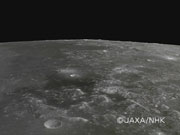
|
|---|
December 5, 2007 Updated
Launch day set for "KIZUNA"
KIZUNA Special Site is now open!
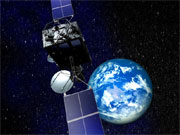 The launch day of the super high-speed Internet satellite "KIZUNA" (WINDS) by H-IIA Launch Vehicle No. 14 (H-IIA F14) has been set at February 15, 2008. The launch time is between 4:27 and 4:39 p.m.(Japan Standard Time, JST.)
The launch day of the super high-speed Internet satellite "KIZUNA" (WINDS) by H-IIA Launch Vehicle No. 14 (H-IIA F14) has been set at February 15, 2008. The launch time is between 4:27 and 4:39 p.m.(Japan Standard Time, JST.)
The "KIZUNA/H-IIA F14 Launch Special Site" is also now open. Please enjoy updated information on the "KIZUNA" and "H-IIA F14" through the special site.
November 2007
November 28, 2007 Updated
Terrain Camera provides unique 3D images of Moon
 JAXA has made detailed images of the Moon’s surface using observation data acquired by the Terrain Camera (TC) onboard the KAGUYA. In a global first, JAXA composed three-dimensional images and a moving image with a very high aerial resolution of 10 meters. The images include the Polar areas on the Moon.
JAXA has made detailed images of the Moon’s surface using observation data acquired by the Terrain Camera (TC) onboard the KAGUYA. In a global first, JAXA composed three-dimensional images and a moving image with a very high aerial resolution of 10 meters. The images include the Polar areas on the Moon.
You can observe small bumps, mounds and craters on the Moon’s surface in a three-dimensional manner that had been invisible to date. (Photo: (c) JAXA/SELENE)
November 13, 2007 Updated
'Earth-rise' and 'Earth-set' images were taken by the KAGUYA
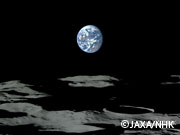 The onboard high definition camera of the moon explorer "KAGUYA," which is under initial functional verification, successfully acquired the world’s first high definition images of an "Earth-rise" and "Earth-set." It was also the world’s first HD images of the Earth from about 380,000 km away in space.
The onboard high definition camera of the moon explorer "KAGUYA," which is under initial functional verification, successfully acquired the world’s first high definition images of an "Earth-rise" and "Earth-set." It was also the world’s first HD images of the Earth from about 380,000 km away in space.
Image: (C) JAXA/NHK
November 7, 2007 Updated
KAGUYA successfully takes images of the moon using HDTV camera!
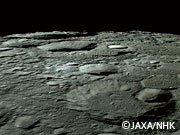 The "KAGUYA," which is currently undergoing initial functional verification, successfully acquired image data using its onboard high definition TV camera (HDTV).
The "KAGUYA," which is currently undergoing initial functional verification, successfully acquired image data using its onboard high definition TV camera (HDTV).
It is the world’s first image taken by the HDTV from 100 km away from the Moon.
Image: (C) JAXA/NHK
October 2007
October 31, 2007 Updated
KAGUYA deployed LMAG mast and LRS antennas
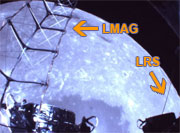 The "KAGUYA"(SELENE,) flying around the moon, successfully extended the Lunar Magnetometer (LMAG) mast and Lunar Radar Sounder (LRS) antennas, and deployed the Upper Atmosphere and Plasma Imager (UPI.)
The "KAGUYA"(SELENE,) flying around the moon, successfully extended the Lunar Magnetometer (LMAG) mast and Lunar Radar Sounder (LRS) antennas, and deployed the Upper Atmosphere and Plasma Imager (UPI.)
(Photo: LMAG mast and LRS antenna shot by the monitor camera to confirm the separation of two baby satellites)
October 21, 2007 Updated
"KAGUYA" moves to regular control mode
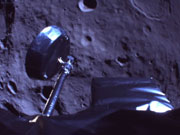 The lunar explorer “KAGUYA” (SELENE), which successfully separated its two baby satellites, has been shifted to the regular control mode to observe the Moon's surface by having the observation equipment face the moon at all times.
The lunar explorer “KAGUYA” (SELENE), which successfully separated its two baby satellites, has been shifted to the regular control mode to observe the Moon's surface by having the observation equipment face the moon at all times.
From now on, the satellite will move to the initial functional verification phase to check out its onboard equipment until mid December. After that, it will start regular observations.
Photo: Moon’s surface shot by the monitor camera of the main satellite from the regular observation orbit.
October 12, 2007 Updated
KAGUYA releases VRAD satellite
"OKINA" and "OUNA" were selected as the nicknames
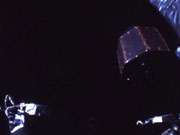 The lunar explorer "KAGUYA" (SELENE) released one of its onboard baby satellites, the VRAD satellite, at 1:28 p.m. on Oct. 12 (Japan Standard Time.)
The lunar explorer "KAGUYA" (SELENE) released one of its onboard baby satellites, the VRAD satellite, at 1:28 p.m. on Oct. 12 (Japan Standard Time.)
"OKINA" and "OUNA" were respectively chosen as nicknames for the Relay satellite and the VRAD satellite in relation with Princess KAGUYA from the Japanese old tale "Taketori Monogatari" (The Tale of the Bamboo Cutter.)
The KAGUYA will further lower its apocynthion altitude to be injected into the circular orbit at an altitude of 100 km.
October 10, 2007 Updated
"KIZUNA" chosen as nickname for "WINDS"!
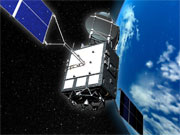 The Wideband InterNetworking engineering Test and Demonstration Satellite (WINDS) is a super-high speed Internet satellite scheduled to be launched in the coming Winter launch season.
The Wideband InterNetworking engineering Test and Demonstration Satellite (WINDS) is a super-high speed Internet satellite scheduled to be launched in the coming Winter launch season.
As a result of asking the public to nominate a nickname for it, 9,657 suggestions were received in total. Among them, "KIZUNA," meaning "ties" or "bonds," was chosen after 452 nominations for it were received, indicating the strong hope for the satellite to play the role of bonding people.
The "KIZUNA" is now undergoing its final verification test at the Tsukuba Space Center. Its launch operations will start in early November at the Tanegasima Space Center.
October 9, 2007 Updated
KAGUYA took images of the Moon and released the Rstar
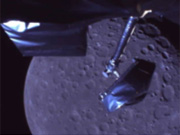 On October 9, the lunar explorer "KAGUYA" (SELENE) released one of its onboard baby satellites, the Relay satellite (Rstar,) at 9:36 a.m.(Japan Standard Time) In addition, the KAGUYA onboard camera to monitor its high-gain antenna captured images of the Moon's surface. The KAGUYA will further lower the altitude of its apocynthion to separate the other babysatellite, the VRAD satellite.
On October 9, the lunar explorer "KAGUYA" (SELENE) released one of its onboard baby satellites, the Relay satellite (Rstar,) at 9:36 a.m.(Japan Standard Time) In addition, the KAGUYA onboard camera to monitor its high-gain antenna captured images of the Moon's surface. The KAGUYA will further lower the altitude of its apocynthion to separate the other babysatellite, the VRAD satellite.
October 5, 2007 Updated
KAGUYA (SELENE) Lunar Orbit Injection was confirmed
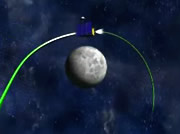 JAXA performed the lunar orbit injection maneuver (LOI1) for the "KAGUYA" (SELENE) at 6:20 a.m. on October 4, 2007 (Japan Standard Time, JST) and have confirmed that the KAGUYA was injected into the lunar orbit.
JAXA performed the lunar orbit injection maneuver (LOI1) for the "KAGUYA" (SELENE) at 6:20 a.m. on October 4, 2007 (Japan Standard Time, JST) and have confirmed that the KAGUYA was injected into the lunar orbit.
We are now pleased to be able to report to you that we have safely delivered messages and signs that were collected from 412,627 people through the Wish upon the Moon Campaign to the Moon. We would like to express our profound appreciation again to all participants.
The "KAGUYA" is now flying in the lunar elliptical orbit at the apocynthion altitude of 11,741 km and pericynthian altitude of 101 km. From now on, it is scheduled to release the Relay satellite first, then the VRAD satellite.
October 1, 2007 Updated
KAGUYA (SELENE) Successful Image Taking by the High Definition Television (HDTV)
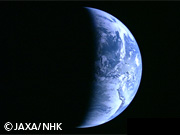 JAXA and NHK (Japan Broadcasting Corporation) have successfully taken high definition moving images through the KAGUYA (SELENE) for the first time.
JAXA and NHK (Japan Broadcasting Corporation) have successfully taken high definition moving images through the KAGUYA (SELENE) for the first time.
The images were taken by the KAGUYA’s onboard High Definition Television (HDTV), which was developed by NHK for space use. It is the first high-definition image shooting of the Earth from so deep in space - about 110,000 km away from the Earth - in human history.
September 2007
September 27, 2007 Updated
KAGUYA smoothly traveling to the Moon
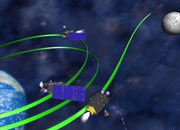 The lunar explorer "KAGUYA" (SELENE) launched by the H-IIA F13 on Sep. 14 from the Tanegashima Space Center is smoothly heading for the moon's orbit with its solar array paddle and high gain antenna successfully deployed.
The lunar explorer "KAGUYA" (SELENE) launched by the H-IIA F13 on Sep. 14 from the Tanegashima Space Center is smoothly heading for the moon's orbit with its solar array paddle and high gain antenna successfully deployed.
We will provide updated information on the "KAGUYA" flight through the Special Site including orbit adjustment, separation of the two baby satellites, the Relay and VRAD satellites, and start of the regular observation orbit flight.
September 14, 2007 Updated
Launch Result of the KAGUYA by the H-IIA Launch Vehicle No. 13
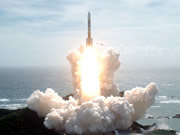 Mitsubishi Heavy Industries, Ltd. and the Japan Aerospace Exploration Agency (JAXA) launched the Lunar Orbit Explorer "KAGUYA" (SELENE) by the H-IIA Launch Vehicle No. 13 (H-IIA F13) at 10:31:01 a.m. on September 14, 2007 (Japan Standard Time, JST) from the Tanegashima Space Center.
Mitsubishi Heavy Industries, Ltd. and the Japan Aerospace Exploration Agency (JAXA) launched the Lunar Orbit Explorer "KAGUYA" (SELENE) by the H-IIA Launch Vehicle No. 13 (H-IIA F13) at 10:31:01 a.m. on September 14, 2007 (Japan Standard Time, JST) from the Tanegashima Space Center.
The launch vehicle flew smoothly, and, at about 45 minutes and 34 seconds after liftoff, the separation of the KAGUYA was confirmed.
(Photo:Mitsubishi Heavy Industries, Ltd.)
September 11, 2007 Updated
Launch Postponement of the KAGUYA (SELENE)/H-IIA F13
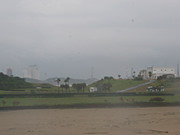 Mitsubishi Heavy Industries, Ltd. and the Japan Aerospace Exploration Agency would like to announce that we have decided to postpone the launch of the Lunar Orbit Explorer "KAGUYA" (SELENE) by H-IIA Launch Vehicle No. 13 (H-IIA F13) as adverse weather conditions are expected during the scheduled countdown operations starting from one day prior to the launch day.
Mitsubishi Heavy Industries, Ltd. and the Japan Aerospace Exploration Agency would like to announce that we have decided to postpone the launch of the Lunar Orbit Explorer "KAGUYA" (SELENE) by H-IIA Launch Vehicle No. 13 (H-IIA F13) as adverse weather conditions are expected during the scheduled countdown operations starting from one day prior to the launch day.
The new launch date will be September 14 (Fri,) 2007 (Japan Standard Time, JST.) The launch time is scheduled for 10:31:01 a.m. (JST.)
We will re-examine the weather and other conditions tomorrow for the launch on the 14th.
The launch was previously scheduled for September 13 (Thu,) 2007 (JST.)
September 10, 2007 Updated
Launch preparations in final stage for KAGUYA/H-IIA F13
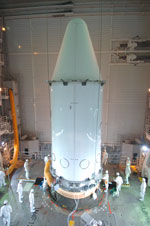 The scheduled launch of the H-IIA F13 with the KAGUYA satellite onboard is just around the corner, and preparations are in their final stages. We will broadcast a live launch report, as we did in the past, from our studio at the Tanegasima Space Center.
The scheduled launch of the H-IIA F13 with the KAGUYA satellite onboard is just around the corner, and preparations are in their final stages. We will broadcast a live launch report, as we did in the past, from our studio at the Tanegasima Space Center.
You can enjoy the live report through various methods including on the Internet, at public viewing spots at JAXA field centers around Japan, JAXA i near Tokyo Station, science museums, cable TV channels, or through mobile phones (FOMA.) The broadcast will start at 9:30 a.m. Please enjoy the broadcast!
* The date and time of the live broadcast is subject to change due to the preparation status or weather.
August 2007
August 15, 2007 Updated
New Launch day of "KAGUYA"
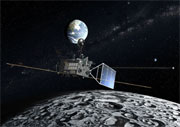 The launch of the Lunar Orbit Explorer "KAGUYA" (SELENE) by H-IIA Launch Vehicle No. 13 (H-IIA F13) was rescheduled for 10:35:47 a.m. on September 13 (Thu), 2007, (Japan Standard Time) after replacement work on parts in the two onboard baby satellites of the "KAGUYA" was successfully completed. We plan to broadcast a live launch report on the launch day. Please enjoy it.
The launch of the Lunar Orbit Explorer "KAGUYA" (SELENE) by H-IIA Launch Vehicle No. 13 (H-IIA F13) was rescheduled for 10:35:47 a.m. on September 13 (Thu), 2007, (Japan Standard Time) after replacement work on parts in the two onboard baby satellites of the "KAGUYA" was successfully completed. We plan to broadcast a live launch report on the launch day. Please enjoy it.
August 9, 2007 Updated
Astronaut Furukawa participating in NEEMO training
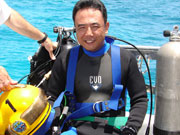 Astronaut Furukawa has been participating in training for the 13th NASA Extreme Environment Mission Operations (NEEMO) between Aug. 6 and 15.
Astronaut Furukawa has been participating in training for the 13th NASA Extreme Environment Mission Operations (NEEMO) between Aug. 6 and 15.
The NEEMO training is underway at the closed facility "Aquarius" of the National Oceanic and Atmospheric Administration (NOAA) in the United States. The astronauts live in the Aquarius, which is placed 20 meters below sea level off Florida, U.S.A., to simulate the space environment. The training aims to improve their leadership, teamwork, and self-control abilities, which are required for future missions, and to develop new technology and mission-operation technology.
You can take a look at real-time images of the training site on the NOAA website. You may be surprised by fish which sometimes appear in the window!
July 2007
July 6, 2007 Updated
Let's compose a "Space Poem Chain" together. The second edition has started.
 The revival of the Space Poem Chain series has long been anticipated and at last the second edition has started.
The revival of the Space Poem Chain series has long been anticipated and at last the second edition has started.
This is an attempt to create an environment for co-working to compose "a series of poems" by thinking about space, the earth and our lives beyond normal boundaries, cultures, generations, specialties and roles. How these 24 poems will be composed is very intriguing.
The application period for the fourth poem will end on Monday July 16, 2007. We are looking forward to your participation.
Further more, this Space Poem Chain series will be placed aboard the Japanese Experiment Module "Kibo," which will be joined with the International Space Station in 2008.
June 2007
June 27, 2007 Updated
Ultra-fast Internet satellite "WINDS" shown to the media at Tsukuba Space Center
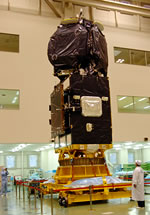 On June 26, 2007, the wideband internetworking engineering test and demonstration satellite (WINDS) was previewed to the media at the Tsukuba Space Center. WINDS has finally reached its last preparation stage ahead of its launch in winter this fiscal year.
On June 26, 2007, the wideband internetworking engineering test and demonstration satellite (WINDS) was previewed to the media at the Tsukuba Space Center. WINDS has finally reached its last preparation stage ahead of its launch in winter this fiscal year.
June 19, 2007 Updated
"KAGUYA" (SELENE) debuts at Tanegashima
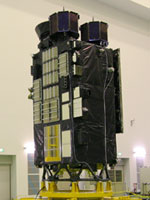 On June 18, 2007, the lunar explorer "KAGUYA" (SELENE) was introduced to the media at the Second Spacecraft Test and Assembly Building at Tanegashima Space Center.
On June 18, 2007, the lunar explorer "KAGUYA" (SELENE) was introduced to the media at the Second Spacecraft Test and Assembly Building at Tanegashima Space Center.
The KAGUYA, which is carrying many messages submitted to the "Wish upon the Moon" campaign, is going to have final adjustments ahead of the launch.
We are still accepting applications from organizations that can support the KAGUYA's mission.
June 13, 2007 Updated
Launch day is set! Special site is open!
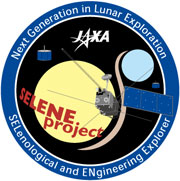 The launch day and time of the lunar explorer "KAGUYA" (SELENE) and the "H-IIA Launch Vehicle No. 13" is set at 9:30:48 a.m. on August 16, 2007. We have opened a Special Web Site for the launch. We will carry the latest news on the "KAGUYA" and the "H-IIA Launch Vehicle No. 13" on these special web pages, so please check them regularly.
The launch day and time of the lunar explorer "KAGUYA" (SELENE) and the "H-IIA Launch Vehicle No. 13" is set at 9:30:48 a.m. on August 16, 2007. We have opened a Special Web Site for the launch. We will carry the latest news on the "KAGUYA" and the "H-IIA Launch Vehicle No. 13" on these special web pages, so please check them regularly.
June 6, 2007 Updated
"KAGUYA" selected as SELENE's nickname!
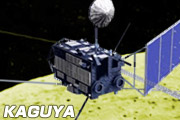 The nickname for the lunar explorer SELENE, which was solicited from the general public, has been selected as the "KAGUYA." We appreciate the many applications we received.
The nickname for the lunar explorer SELENE, which was solicited from the general public, has been selected as the "KAGUYA." We appreciate the many applications we received.
In addition, a Special Web Site for the "KAGUYA /H-IIA Launch Vehicle No.13" will be open for the launch.
May 2007
May 31, 2007 Updated
Observation data from HINODE (SOLAR-B) released to the public!
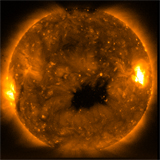 The Solar Observation Satellite HINODE (SOLAR-B) has been regularly carrying out observations using all its observation instruments. Previously, we have released only a limited portion of images from the HINODE on our web site, but on May 27, 2007, we disclosed all the observation data to the world. To commemorate this achievement, we have also released videos of long term x-ray observations and the latest images from the X-Ray Telescope (XRT) on our web site.
The Solar Observation Satellite HINODE (SOLAR-B) has been regularly carrying out observations using all its observation instruments. Previously, we have released only a limited portion of images from the HINODE on our web site, but on May 27, 2007, we disclosed all the observation data to the world. To commemorate this achievement, we have also released videos of long term x-ray observations and the latest images from the X-Ray Telescope (XRT) on our web site.
May 14, 2007 Updated
"Italy in Space"
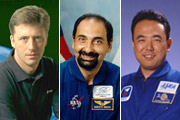 As part of the Italian festival "PRIMAVERA ITALIANA", the Agenzia Spaziale Italiana (ASI, Italian Space Agency) and JAXA will co-host an event called "Italy in Space." Following a space fashion show by Japanese and Italian designers, the space engineering exhibition, "Italy in Space," will also be held at the Shiodomeitalia Creative Center between May 19 and June 3. Italian cutting-edge space engineering technology will be introduced there.
As part of the Italian festival "PRIMAVERA ITALIANA", the Agenzia Spaziale Italiana (ASI, Italian Space Agency) and JAXA will co-host an event called "Italy in Space." Following a space fashion show by Japanese and Italian designers, the space engineering exhibition, "Italy in Space," will also be held at the Shiodomeitalia Creative Center between May 19 and June 3. Italian cutting-edge space engineering technology will be introduced there.
A symposium for disaster preparation using space technology and lectures by an Italian Astronaut and JAXA Astronaut Furukawa will also be held on May 23 and May 29 respectively at the "Istituto Italiano di Culture (Italian Culture Center.)"
Please stop by at these events with your friends.
- PRIMAVERA ITALIANA (In Japanese)
April 2007
April 4, 2007 Updated
Hayabusa to start return trip to Earth in mid April
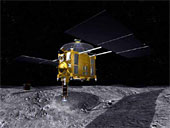 The asteroid explorer "Hayabusa" which landed on the asteroid "Itokawa" November 2005, delivered its probe container for acquired samples to the re-entry capsule, stored it in the capsule, then tightly shut the lid (with latches and seals.)
The asteroid explorer "Hayabusa" which landed on the asteroid "Itokawa" November 2005, delivered its probe container for acquired samples to the re-entry capsule, stored it in the capsule, then tightly shut the lid (with latches and seals.)
Since February, JAXA tried a new attitude control method to operate the ion engine, and engine running trials in phases have been underway since late March.
It is scheduled to start fully fledged engine operations in mid April to return to Earth.
The operation of the Hayabusa is still undergoing difficulties, but JAXA will do its utmost to make the explorer return home in June 2010.
March 2007
March 26, 2007 Updated
Astronaut Hoshide selected as Space Shuttle crewmember
 JAXA Astronaut Akihiko Hoshide was selected as a crewmember for the second Space Shuttle mission to assemble the Japanese Experiment Module "Kibo" (STS-124/1J.) He is scheduled to fly to the International Space Station (ISS) on the Space Shuttle Atlantis with the Kibo Pressurized Module in early 2008. He will stay at the ISS for about two weeks.
JAXA Astronaut Akihiko Hoshide was selected as a crewmember for the second Space Shuttle mission to assemble the Japanese Experiment Module "Kibo" (STS-124/1J.) He is scheduled to fly to the International Space Station (ISS) on the Space Shuttle Atlantis with the Kibo Pressurized Module in early 2008. He will stay at the ISS for about two weeks.
Following this selection, three Japanese astronauts are currently scheduled to fly on space shuttles, namely Astronaut Takao Doi on STS-123 (with Astronaut Naoko Yamazaki as a crew support astronaut,) Astronaut Akihiko Hoshide on STS-124, and Astronaut Koichi Wakata (with Astronaut Soichi Noguchi as a backup crewmember) to stay at the ISS for a prolonged period.
March 13, 2007 Updated
ELM Pressurized Section of "Kibo" arrives in the US
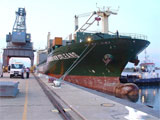 The Experiment Logistics Module (ELM) Pressurized Section of the Japanese Experiment Module "Kibo" arrived at Port Canaveral adjacent to NASA Kennedy Space Center. The Kibo is scheduled to be connected with the International Space Station.
The Experiment Logistics Module (ELM) Pressurized Section of the Japanese Experiment Module "Kibo" arrived at Port Canaveral adjacent to NASA Kennedy Space Center. The Kibo is scheduled to be connected with the International Space Station.
The ELM Pressurized Section will be transported to the Space Station Processing Facility (SSPF) at the Kennedy Space Center to be ready for launch.
The ELM Pressurized Section will be launched by the first Space Shuttle mission, which Astronaut Takao Doi will be aboard, for the assembly of the "Kibo."
March 1, 2007 Updated
Space Exploration Symposium
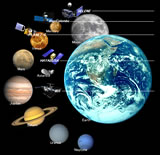 A "Space Exploration Symposium" will be held in Kyoto on March 6 and 7.The symposium will discuss the future of space exploration and will invite domestic and international specialists to participate. The heads of JAXA, NASA and ESA will give keynote lectures on their current space exploration projects. This is a good opportunity to catch up with the latest information on global space exploration projects. (Participants are required to register by the morning of March 5.)
A "Space Exploration Symposium" will be held in Kyoto on March 6 and 7.The symposium will discuss the future of space exploration and will invite domestic and international specialists to participate. The heads of JAXA, NASA and ESA will give keynote lectures on their current space exploration projects. This is a good opportunity to catch up with the latest information on global space exploration projects. (Participants are required to register by the morning of March 5.)
At the same time, models of the HAYABUSA, the International Space Station, and HTV, and a space suit and food will be on display (no pre-registration is required for the exhibition.)
This is the dawn of a great exploration era for our Solar System.
February 2007
February 13, 2007 Updated
Astronaut Wakata selected as crew member for ISS Expedition
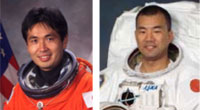 JAXA Astronaut Koichi Wakata was selected as a crew member of the 18th Expedition for a three-month stay on the International Space Station (ISS), and Astronaut Soichi Noguchi was chosen as his backup. Astronaut Wakata's stay there is scheduled for Japan Fiscal Year 2008. This is the first time a Japanese astronaut has been selected as a crew member to stay on the ISS for a lengthy time.
JAXA Astronaut Koichi Wakata was selected as a crew member of the 18th Expedition for a three-month stay on the International Space Station (ISS), and Astronaut Soichi Noguchi was chosen as his backup. Astronaut Wakata's stay there is scheduled for Japan Fiscal Year 2008. This is the first time a Japanese astronaut has been selected as a crew member to stay on the ISS for a lengthy time.
February 1, 2007 Updated
JAXA Website Renewal!
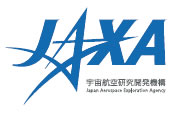 On February 1, the JAXA Website was reborn with the aim to become a website that is easier for users to view.
On February 1, the JAXA Website was reborn with the aim to become a website that is easier for users to view.
A new function, "RSS distribution," enables us to transmit to users JAXA's latest information including "press releases" and "lists of updated items." (RSS reader is needed to receive the distribution.)
We hope you enjoy the renewed JAXA website.
January 2007
January 16, 2007 Updated
Launch success of "S-310-37"
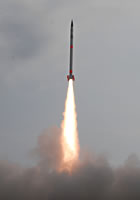 On January 16, the sounding rocket "S-310-37" was launched at 11:20 a.m. from the Uchinoura Space Center. The purpose of the rocket is to elucidate the mechanism of the generation of the high electron temperature sphere in the lower part of the ionosphere.
On January 16, the sounding rocket "S-310-37" was launched at 11:20 a.m. from the Uchinoura Space Center. The purpose of the rocket is to elucidate the mechanism of the generation of the high electron temperature sphere in the lower part of the ionosphere.
The flight and operation of the on-board equipment went normally, and at 59 seconds after liftoff, the top part of the rocket opened.
Subsequently, the rocket started observations at 60 seconds. All observations were completed after it reached its highest altitude of 138 km at 184 seconds, then it fell into the sea south-east of Uchinoura.
The experiment went smoothly as planned, and through the on board electronic temperature measurement equipment we have confirmed that the high-temperature sphere existed at an altitude of 99 to 101 km.
January 12, 2007 Updated
The President's New Year Interview, 2007
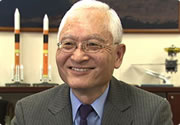 There is so much to look forward to in space development this year. After launching six rockets last year, we will launch two more, as well as the Japanese experiment module for the International Space Station (ISS), which will take off aboard the space shuttle.
There is so much to look forward to in space development this year. After launching six rockets last year, we will launch two more, as well as the Japanese experiment module for the International Space Station (ISS), which will take off aboard the space shuttle.
We hope you will follow these and other exciting events with interest. We will do our best to succeed.